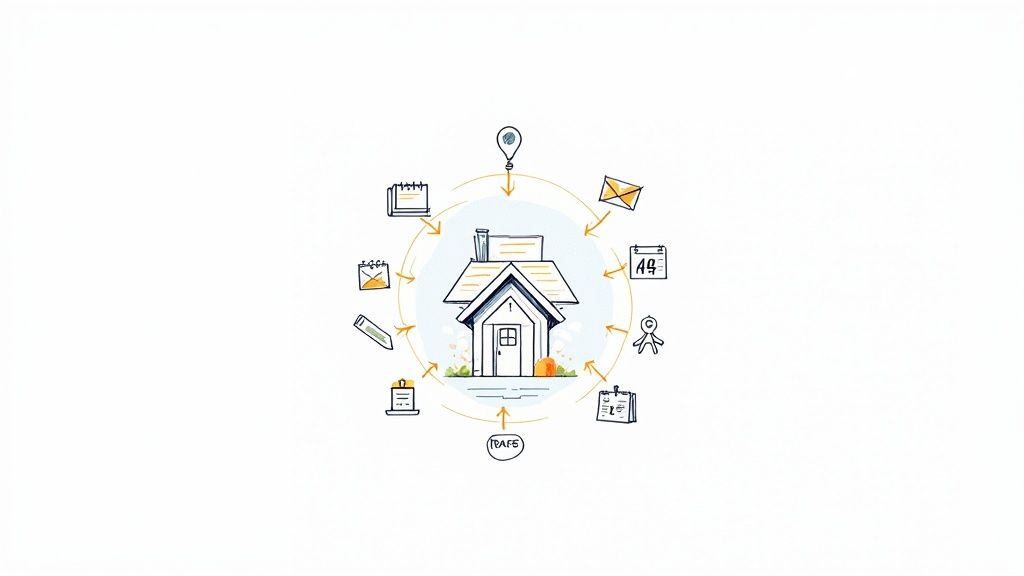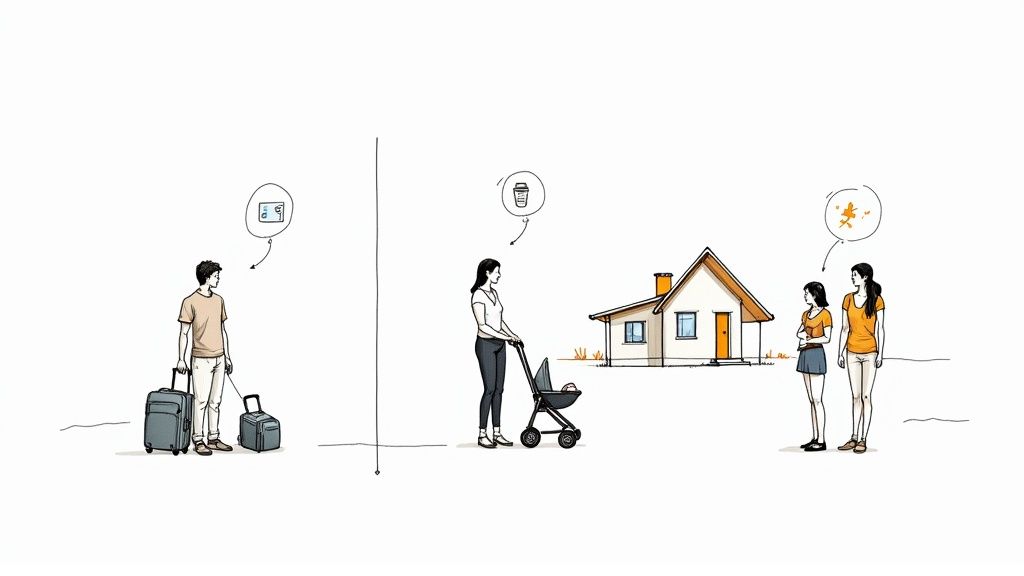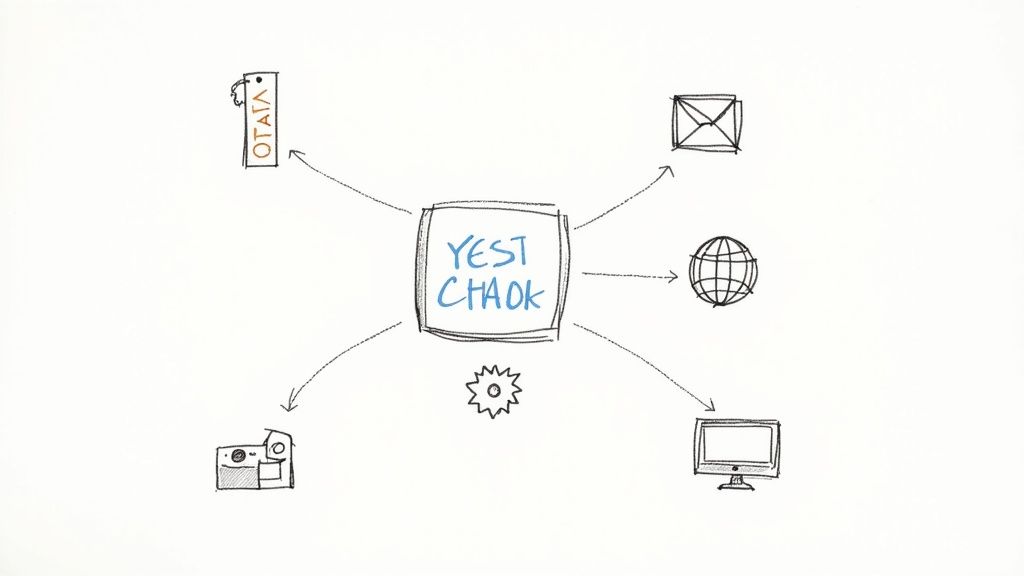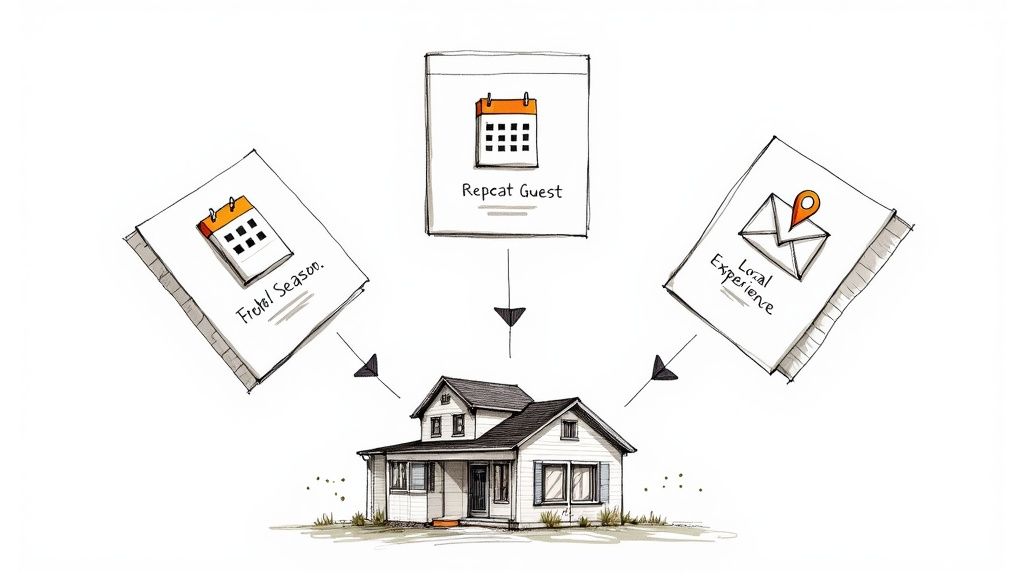
vacation rental marketing
Vacation Rental Marketing That Fills Your Calendar
Posted on Nov 15, 2025

So, what exactly is vacation rental marketing? It’s the game plan property managers use to promote their rentals, connect with the right guests, and keep the bookings coming. It's so much more than just throwing a listing up online; it's the art and science of making your rental seen, wanted, and consistently profitable in a very crowded market.
Why Vacation Rental Marketing Matters More Than Ever
Picture your property as a hidden gem. No matter how incredible it is, it stays hidden without a map. That map is your marketing strategy—a clear guide that leads a steady stream of travelers straight to your door. In a world overflowing with options, having a fantastic property just isn't enough to guarantee a full calendar anymore.

The old "list it and forget it" mindset is officially dead. It’s been replaced by a dynamic, multi-channel approach that requires real thought. The most successful managers today know that marketing is the engine that drives their entire business forward.
A proactive marketing plan doesn't just fill empty nights; it builds a resilient, profitable business that can thrive in any market condition. It’s the difference between being a passive property owner and an active business operator.
The Shift To a Strategic Approach
The vacation rental market is absolutely booming. It’s on track to hit USD 396.93 billion by 2032, fueled by travelers who crave unique and flexible places to stay. This explosion creates incredible opportunities, but it also means you're up against a mountain of competition.
To cut through the noise, your marketing needs to nail three things:
- Boost Visibility: Get your property in front of guests right where they’re searching, whether that’s on big OTAs or through a specific Google search.
- Build Trust: Use stunning photos, descriptions that tell a story, and glowing reviews to show travelers you’re the real deal.
- Drive Revenue: Attract the kind of guests who are happy to pay your rates, leading to higher occupancy and a healthier bottom line.
Building Your Foundational Pillars
Before you can start executing, you need a solid foundation. Let's break down the essential components of a modern marketing strategy.
We’ve put together a quick overview of what a modern, robust marketing plan looks like. Think of these as the core pillars holding up your business. Each one has a specific job to do, from grabbing attention to securing that final booking.
Core Pillars of a Modern Vacation Rental Marketing Plan
| Marketing Pillar | Primary Objective | Key Activities |
|---|---|---|
| Brand & Positioning | Differentiate from competitors and attract ideal guests. | Define your unique selling proposition (USP), create a brand identity, and craft a compelling property story. |
| Direct Booking Website | Own the guest relationship and maximize profit by avoiding OTA fees. | Build an SEO-optimized, mobile-friendly website with an integrated booking engine and high-quality visuals. |
| Multi-Channel Distribution | Increase visibility and reach a wider audience across various platforms. | List on relevant OTAs (like Airbnb, Vrbo), metasearch sites (Google Vacation Rentals), and niche booking sites. |
| Digital Advertising | Drive targeted traffic and generate immediate booking inquiries. | Run paid search (PPC) ads, social media ads (Facebook/Instagram), and retargeting campaigns to capture interested travelers. |
| Content & SEO | Attract organic traffic and establish authority by providing valuable information. | Create blog posts about local attractions, optimize property descriptions with relevant keywords, and build a local guide. |
| Guest Communication & CRM | Foster loyalty, encourage repeat bookings, and generate positive reviews. | Implement automated email sequences, manage a guest database (CRM), and request reviews post-stay. |
| Reputation Management | Build trust and social proof to convert potential bookers into confirmed guests. | Monitor and respond to all reviews, showcase positive testimonials, and maintain a high average rating. |
Each pillar works together to create a powerful, self-sustaining marketing machine. Understanding the importance of online reputation management is just as critical as your pricing strategy. Similarly, focusing on direct connections with guests is a game-changer. Learning about the advantages of direct bookings for small vacation rental businesses can completely reshape how you view your profitability.
This guide isn't about high-level theory. We’re getting into the weeds with actionable frameworks you can start using today. We’ll break down every piece of the puzzle, from figuring out who your perfect guest is to mastering the channels that will deliver bookings day in and day out.
Finding and Attracting Your Ideal Guests
Trying to market your vacation rental without knowing exactly who you're talking to is like throwing a party and forgetting to send out invitations. You might get a few stragglers, but you won't get the crowd you want. Real, effective marketing starts with a deep, almost personal understanding of the guests you want to attract.

This goes way beyond generic labels like "families" or "couples." We're talking about creating detailed guest personas—vivid profiles of your perfect visitors, complete with their hopes, headaches, and travel dreams. Knowing them inside and out is the secret key that unlocks every other marketing decision you'll make.
When you have a crystal-clear picture of your ideal guest, everything else just clicks into place. Your photos will showcase the features they actually care about. Your headlines will speak their language. Your whole marketing strategy shifts from a hopeful shout into the void to a magnetic whisper aimed directly at them.
Building Your Core Guest Personas
Think of your guest persona as the main character in your property's story. To bring them to life, you need to know their backstory, what they hope to get out of their trip, and what frustrations they're trying to avoid. The more specific, the better.
So, instead of targeting "families," you create a persona for "The Multigenerational Family Reunion Planner." This isn't just any family. This is a group led by a busy parent in their 40s, desperately trying to coordinate a trip that keeps grandparents, teenagers, and toddlers happy all at once.
What do they really need?
- Accessibility: A ground-floor bedroom so Grandma doesn't have to tackle the stairs.
- Space: A massive dining table for chaotic family dinners and separate living areas for when people need a break from each other.
- Entertainment: A game room to keep the teens from getting bored and a fenced-in yard for the little ones to run around safely.
See the difference? Suddenly, you're not just selling a "4-bedroom house." You're offering "the perfect, stress-free home for making lifelong family memories."
A well-defined guest persona is your strategic compass. It guides your amenity choices, your pricing strategy, and the very words you use to describe your property, ensuring every decision is aimed at attracting and delighting your ideal guest.
From Persona to Practical Application
Let's break it down with another common profile: "The Digital Nomad Duo." This isn't just any couple. They're remote professionals who need a space that functions as both an office and a retreat. Understanding this completely changes how you pitch your rental.
Here’s a quick look at how you'd market to them versus a generic "couple":
| Marketing Element | Generic "Couple" Focus | "Digital Nomad Duo" Focus |
|---|---|---|
| Headline | "Romantic Getaway with King Bed" | "Your Stylish Work-From-Home Base with Fiber Optic WiFi" |
| Photos | Cozy fireplace, wine glasses, bathtub. | A dedicated workspace with an ergonomic chair, plenty of outlets, and great natural light. |
| Description | Highlights privacy and ambiance. | Emphasizes blazing-fast internet (mentioning actual upload/download speeds), proximity to coffee shops, and discounts for weekly stays. |
This focused approach works for any guest type you can imagine. Trying to attract a "Bachelorette Weekend Crew"? Your marketing should be full of photos of your group-friendly living space, details about how close you are to the best nightlife, and mentions of your "Instagrammable" backdrops. It makes potential guests feel like you built the place just for them.
The words you choose are just as critical. The right story can make all the difference. For a masterclass in tailoring your message, check out these vacation rental property description examples to see how it's done. At the end of the day, truly knowing your guest turns your marketing from a generic broadcast into a personal, irresistible invitation.
Mastering the Channels That Drive Bookings
Alright, you've pinpointed exactly who you're trying to attract. Now comes the fun part: meeting them where they hang out online.
Think of your marketing channels as different paths leading to your property's front door. Some are massive, bustling highways packed with travelers of all kinds. Others are quiet, scenic backroads for those searching for something very specific. Your job is to make sure your rental is a can't-miss landmark on the right paths for your ideal guest.

Let's be clear: the vacation rental game is played online. A recent jaw-dropping statistic showed that online sales made up 79% of all vacation rental revenue. That’s not just a trend; it's a fundamental shift in how people find and book their stays. The giants in this space are household names—Airbnb, Expedia (which owns Vrbo), and Booking.com. You simply have to be on these digital platforms to compete.
But this isn't about planting your flag everywhere at once. It's about being strategic and effective where it really counts. We’ll break down the most important channels, from the powerhouse Online Travel Agencies (OTAs) to the brand-building goldmine of your own website.
Choosing Your Marketing Channels Wisely
Deciding where to invest your time and money can feel overwhelming. This table breaks down the core channels to help you align your efforts with your goals, whether that's immediate visibility or long-term brand building.
| Channel | Key Strength | Primary Challenge | Best For |
|---|---|---|---|
| OTAs (Airbnb, Vrbo) | Instant access to a massive audience | High competition & commission fees | New hosts needing quick visibility and bookings. |
| Direct Booking Website | 100% revenue, brand control, guest data | Building traffic takes time and effort (SEO/PPC) | Established hosts focused on profitability and repeat guests. |
| Email Marketing | High ROI, direct communication with past guests | Building a subscriber list takes time | Driving repeat bookings and filling shoulder-season gaps. |
| Social Media | Brand building, community engagement | Can be time-consuming with uncertain direct ROI | Showcasing property personality and attracting niche audiences. |
| Paid Ads (PPC/Retargeting) | Highly targeted, immediate traffic | Can be expensive without proper management | Driving traffic for specific dates or to a direct booking site. |
Each channel plays a unique role. OTAs get you in the game, but a direct website and email list are how you build a sustainable business for the long haul.
Winning on OTAs Like Airbnb and Vrbo
Online Travel Agencies are the superhighways of the vacation rental world. They attract millions of eyeballs every day and offer a built-in audience you just can't ignore, especially when you're just starting out. Listing on platforms like Airbnb and Vrbo gives your property instant visibility—no question about it.
But just showing up isn't enough. You’re in a sea of thousands of other properties, so you need to play their game... and win. The secret is learning to work with their search algorithms, not against them.
Think of an OTA's algorithm as a super-efficient concierge. When a traveler searches for a "3-bedroom cabin with a hot tub," the algorithm's job is to present the best, most relevant, and most trustworthy options first. Your mission is to convince that digital concierge that your property is the perfect match.
Here’s how you do it:
- Nail Your Listing Title and Description: Use the exact keywords your ideal guest is typing into the search bar, like "pet-friendly," "walkable to downtown," or "oceanfront views."
- Be Incredibly Responsive: OTAs love hosts who reply to inquiries fast. It signals a great guest experience is on the way, and they'll reward you with a bump in visibility.
- Become a Review Magnet: Positive reviews are the ultimate currency of trust. Don't be shy about encouraging guests to leave feedback after their stay.
- Keep Your Calendar Spotless: An accurate, up-to-date calendar tells the algorithm you're an active, reliable host who is ready for business.
Consistently hitting these marks sends strong signals to the platform that you're a top-tier host. That's how you climb the search rankings and get in front of more potential guests.
Building Your Brand with a Direct Booking Website
While OTAs provide reach, a direct booking website gives you control. It’s your own little corner of the internet where you make the rules, own the guest relationship, and—most importantly—keep 100% of the revenue by cutting out those hefty OTA commissions. This is the foundation of any serious, long-term vacation rental marketing strategy.
Your website is so much more than a booking engine; it's the home of your brand. It’s where you can tell your property's unique story, showcase those stunning full-screen photos, and offer special packages you can't list anywhere else. A key part of mastering this channel is a solid focus on comprehensive SEO services, which helps you show up in Google when guests search for places like yours.
A direct booking website transforms you from just another listing into a legitimate, independent hospitality brand. It's the ultimate tool for building guest loyalty and long-term profitability.
For your website to actually work, it needs to provide a booking experience that is seamless and trustworthy. Slow pages, confusing navigation, or a clunky payment process will send potential guests scrambling back to the familiar safety of an OTA. It’s also a powerful asset that pairs beautifully with paid advertising. For a deep dive on this, check out our guide on how PPC and SEO work together.
Fostering Loyalty with Email Marketing
Email marketing is your private line to your most valuable audience: past guests. These are people who already know your property, had a good experience, and trust you. It's easily one of the most cost-effective ways to drive repeat bookings and fill up your calendar during the slower seasons.
Start by collecting email addresses from every single guest (with their permission, of course). From there, you can build a powerful connection by sending them valuable, non-salesy content that keeps you on their radar.
Your email strategy could include things like:
- Seasonal Promotions: Send an exclusive "friends and family" discount to past guests for a fall colors trip or a last-minute summer getaway.
- Local Event Spotlights: Give them a heads-up about an upcoming music festival or holiday market in your area, positioning your rental as the perfect home base.
- Loyalty Offers: Create a simple "welcome back" package with a small local gift or a guaranteed early check-in for anyone who has stayed before.
The goal is to stay top-of-mind without being annoying. A well-timed, thoughtful email can be the gentle nudge that turns a one-time visitor into a loyal fan who books with you year after year.
Crafting High-Impact Marketing Campaigns
If your strategy is the roadmap, then your marketing campaigns are the engine that actually moves your business forward. A solid campaign takes everything we've talked about—your ideal guest, your property's unique charm, and a specific business goal—and mixes them into a focused, time-bound push that gets real bookings on the calendar.
This is the shift from passively listing your property to proactively marketing it.

Instead of just waiting for travelers to stumble upon your listing, campaigns let you reach out and actually create demand. Let's walk through three proven campaign blueprints you can steal and adapt for your own vacation rental, turning those quiet periods into profitable opportunities and first-time guests into lifelong fans.
Campaign Blueprint 1: Fill Your Shoulder Season
Every market has them. Those in-between months when the booking calendar starts looking a little sparse. This campaign is all about turning that downtime into a revenue stream by giving guests a compelling reason to visit now.
The secret is to shift the focus away from just your property and onto the unique local experiences that are only available during this specific time. Think of it as selling the destination first, with your rental as the perfect home base for the adventure.
- Objective: Increase occupancy by 25% during the slow months of October and November.
- Target Guest: "The Weekend Explorer"—couples or small groups living within a 3-hour drive who are looking for an easy, affordable getaway.
- Core Message: "Escape the crowds and experience the authentic side of [Your Town]. Discover local harvest festivals, cozy brewery tours, and stunning autumn hikes."
To pull this off, you'd create a "Fall Getaway" package on your direct booking site. Bundle a 2-night stay with a small discount and a curated list of local events. Then, promote this offer with targeted social media ads aimed at users in nearby cities and an email blast to your past guest list, playing up the appeal of an off-season trip.
Campaign Blueprint 2: The Repeat Guest Loyalty Offer
Your most valuable asset isn't your hot tub or your king-sized bed; it's a happy past guest. They already trust you, they know your property, and they're way more likely to book again than a total stranger. This email-driven campaign is all about nurturing that relationship and rewarding their loyalty.
The goal here isn't just to snag another booking. It's to make past guests feel like VIPs with access to exclusive perks. This tightens their connection to your brand and, crucially, encourages them to book directly, saving you a chunk of change on OTA commission fees.
Your guest database isn't just a list of names; it's a goldmine of potential revenue. A targeted email campaign is the most direct and cost-effective way to reactivate past customers and drive high-margin, direct bookings.
Here’s the play-by-play:
- Objective: Secure 10 repeat bookings for the upcoming peak season before you open the calendar to the public.
- Target Guest: Anyone who has stayed with you in the last 18 months and left a 4 or 5-star review.
- Core Message: "As a thank you for being one of our favorite guests, we’re giving you exclusive early access to book your summer dates before anyone else—with a special returning guest rate."
- Timeline: Roll out a three-part email sequence over two weeks. The first email announces the early access window. The second sends a friendly reminder. The final email creates a little urgency by highlighting the date when bookings open to everyone.
This simple, low-cost campaign can fill a huge portion of your peak season calendar with zero ad spend. It's a perfect example of the immense power of email in your marketing toolkit.
Campaign Blueprint 3: The Local Experience Social Campaign
This campaign taps into the power of collaboration and authentic content to grab the attention of guests who want more than just a place to sleep. You're not just selling a rental; you're selling a unique, curated experience they can't get anywhere else.
By teaming up with nearby businesses—a local winery, a popular cafe, a yoga studio, or a guided tour operator—you create a package that adds massive value to a guest's stay. This not only makes your property shine but also generates fantastic, shareable content for your social media channels.
- Objective: Increase social media engagement and drive traffic to a new "Local Packages" page on your website.
- Target Guest: "The Experience Seeker"—travelers who prioritize unique activities and authentic local culture over the usual tourist traps.
- Core Message: "Don't just visit—live like a local. We've partnered with the best spots in town to bring you exclusive packages for an unforgettable stay."
You can promote this by creating content with your partners, like a joint Instagram giveaway or a video tour showing off the combined experience. This cross-promotion gets your rental in front of their audience and vice-versa, creating a powerful marketing synergy that helps everyone win.
Using Smart Pricing to Outperform Competitors
Great marketing might get thousands of eyes on your listing, but the wrong price will stop potential guests cold. Pricing isn't just about picking a number; it's one of the most powerful marketing tools you have. It signals your property's value, helps you manage demand, and goes straight to your bottom line. It's the final, crucial piece that turns a curious browser into a confirmed booking.
Think of your pricing strategy like a DJ reading the room. It needs to sync up with seasonality, local events, and what your competitors are doing to create a profitable vibe. Sticking to one flat rate all year is like playing the same song on repeat—you're leaving a ton of money on the table.
Understanding Dynamic Pricing
The heart of any modern pricing strategy is dynamic pricing. This just means your rates are fluid, changing automatically based on what's happening in the market in real-time. It’s the same reason a flight to Miami costs a fortune during spring break but is a bargain in late September.
Your pricing should react to a few key signals:
- Seasonality: The obvious high and low seasons need different base rates. No surprise there.
- Local Events: Is there a huge concert, festival, or conference in town? Your rates should jump to reflect that spike in demand.
- Competitor Actions: Keeping an eye on what similar properties are charging helps you stay in the game without starting a race to the bottom.
- Booking Lead Time: You can adjust prices to fill last-minute gaps or reward early birds to lock in revenue well in advance.
This is where automation becomes your best friend. Tools like hostAI can handle this for you, analyzing market data to set the perfect price for every single night. This ensures you never leave money on the table on a high-demand date or price yourself out of a booking during a slow spell.
Positioning Your Property for Profit
Beyond just the numbers, how you price your property is tied directly to your brand. It sends a loud and clear message about the kind of experience guests should expect. Are you the budget-friendly basecamp for weekend adventurers or a premium, quiet escape for those seeking a little luxury?
Your pricing has to match the story you're telling with your photos, descriptions, and amenities. A high-end property with killer professional photos and five-star reviews can easily command a premium rate. On the flip side, trying to charge luxury prices for a place with basic furniture and grainy phone pictures will just get you an empty calendar.
Your price is a promise. It sets guest expectations before they even walk in the door. Make sure your property's experience consistently delivers on that promise, and you'll build a brand that justifies every dollar.
The market is still hot for properties that nail this. Even with a flood of new listings, occupancy rates in mature markets like North America recently hit 51%. This has driven up average daily rates (ADR), proving that guests are absolutely willing to pay for quality. You can dig into the full short-term rental market performance report for more details.
Smart pricing isn't just about jacking up rates on holidays. It’s about using smaller, tactical adjustments to keep your calendar full. Think about adding these to your playbook:
- Weekend Premiums: A classic move to capture higher demand on Fridays and Saturdays.
- Minimum Night Stays: Use longer minimums during your busy season (like 5-7 nights) and shorter ones in the off-season (2-3 nights) to maximize your occupancy without creating awkward gaps.
- Last-Minute Discounts: Offer a small discount for unbooked nights within the next 2-3 days. This can attract spontaneous travelers and save you from a costly vacant night.
When you combine smart, data-driven dynamic pricing with a crystal-clear brand position, your rates transform from a simple number into a strategic weapon. You'll outsmart the competition and keep those booking notifications rolling in.
Measuring the Metrics That Actually Matter
Guesswork doesn't build a profitable vacation rental business. Smart, informed decisions do. But how can you be sure your marketing efforts are actually moving the needle? The answer is in the data—specifically, the key performance indicators (KPIs) that tell the true story of your business's health.
Focusing on the right metrics cuts through the noise and shows you exactly what’s working and what isn’t. Think of them as your business's vital signs. Just like a doctor checks your heart rate to assess your health, you need to monitor these numbers to diagnose problems, spot opportunities, and confidently steer your strategy toward growth.
The Three Core Vitals of Your Rental Business
You could track dozens of different data points, but only three KPIs form the bedrock of performance for any vacation rental. Get a handle on these, and you'll have a crystal-clear picture of your success.
- Occupancy Rate: This one’s the most straightforward. It’s simply the percentage of nights your property was booked out of the total number of nights it was available. A high occupancy rate feels great, but it’s only one piece of the puzzle.
- Average Daily Rate (ADR): Your ADR is the average revenue you earn for each night that gets booked. To find it, just divide your total rental revenue by the number of nights booked. This metric tells you how much you're actually earning on the nights you manage to fill.
- Revenue Per Available Night (RevPAN): This is the master metric that ties the other two together. RevPAN shows you how much revenue you're generating for every available night—booked or not. It gives you the most accurate view of your overall earning power and marketing effectiveness.
Understanding RevPAN is the key to unlocking true profitability. It balances your occupancy with your nightly rate, preventing you from chasing a full calendar with low-value bookings that ultimately hurt your bottom line.
Turning Data Into Smarter Decisions
So, what do you do with all these numbers? You use them to ask better questions and find better answers.
For instance, if your occupancy is high but your RevPAN is lagging, it’s a red flag that your nightly rates are too low. You're keeping the lights on and the cleaners busy, but you're leaving money on the table.
On the flip side, a high ADR paired with low occupancy suggests your prices might be scaring away potential guests. Your goal is to find that sweet spot where occupancy and ADR work in harmony to push your RevPAN to its maximum potential.
This is where having the right tools makes a world of difference. Instead of crunching these numbers in a spreadsheet, a platform like hostAI can track these metrics for you in real-time. It can analyze performance and even adjust your pricing automatically to nail that profitable sweet spot. By making data-driven tweaks, you can put your marketing dollars where they'll deliver the highest return and grow your business with confidence.
Your Vacation Rental Marketing Questions, Answered
Jumping into vacation rental marketing can feel like trying to solve a puzzle with a million pieces. Where do you even start? What really moves the needle? We get these kinds of questions all the time, so let's clear up a few of the most common ones.
How Much Should I Actually Spend on Marketing?
There's no single magic number here, but a good rule of thumb is to earmark around 5-10% of your total booking revenue for marketing. Think of it as a starting point, not a hard-and-fast rule.
If you’re launching a brand-new property, you'll probably want to lean toward the higher end of that range. You need to build some serious momentum early on and get those first critical reviews in the door. The most important thing, though, is to watch your return on investment (ROI) like a hawk. If your Google Ads are consistently bringing in high-value direct bookings, it makes perfect sense to double down and feed that channel.
Should I Focus on OTAs or My Own Direct Booking Site?
This isn't an either/or question. The smartest, most sustainable strategy is to make them work together. A balanced approach is your best bet for long-term growth.
Think of it this way: OTAs like Airbnb and Vrbo are your acquisition engine. They put your property in front of a massive, ready-to-book audience you couldn't reach on your own. Your direct booking website, on the other hand, is your retention engine. It's where you build your brand, cultivate guest loyalty, and seriously boost your profits by cutting out those hefty commission fees.
Our advice? Start by absolutely mastering your OTA listings to get bookings flowing. Once you have a solid base of happy guests, you can start strategically encouraging them to book directly with you for their next trip.
What’s the Single Most Important Part of My Listing?
Hands down, it's your photos. High-quality, professional photography is non-negotiable.
In the online world, guests are buying with their eyes. Your photos are your first impression, your best sales pitch, and your biggest opportunity to make someone stop scrolling and imagine themselves in your space. They sell the experience, not just the room.
Before you spend a single dollar on ads or an hour rewriting your description, get a professional photographer in there. It's the highest-impact investment you can make in your marketing, and it pays for itself over and over by turning casual browsers into confirmed guests.
Ready to stop guessing and start growing your direct bookings? hostAI provides the intelligent tools you need to automate your email marketing, launch a high-converting website, and run ads that deliver real results. Discover how our platform can double your direct revenue at https://gethostai.com.